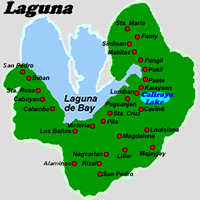Profile
of Laguna
 Laguna,
Resort Province of the Philippines, is a haven of fresh and pristine
bodies of water such as hot springs, lakes, and waterfalls. Most
notable is Pagsanjan Falls. It is found in Cavinti, starting from
Pagsanjan town. Another is Caliraya Lake, which is located between
Cavinti and Lumban. The strong mountain breeze that blows from
the Sierra Madre Mountain Ranges and the distant Mount Banahaw
makes the lake an ideal place for aqua sports like wind surfing,
water skiing, sailing as well as game fishing. Laguna de Bay,
Southeast Asia's largest fresh water lake, stays pristine throughout
the year due to regular rain showers.
Laguna,
Resort Province of the Philippines, is a haven of fresh and pristine
bodies of water such as hot springs, lakes, and waterfalls. Most
notable is Pagsanjan Falls. It is found in Cavinti, starting from
Pagsanjan town. Another is Caliraya Lake, which is located between
Cavinti and Lumban. The strong mountain breeze that blows from
the Sierra Madre Mountain Ranges and the distant Mount Banahaw
makes the lake an ideal place for aqua sports like wind surfing,
water skiing, sailing as well as game fishing. Laguna de Bay,
Southeast Asia's largest fresh water lake, stays pristine throughout
the year due to regular rain showers.
Numerous hot springs abound in the province, including the famous
Hidden Valley Springs which is located in a secluded part of Alaminos
town. A trip to Dalitiwan River, located in Botocan, Majayjay,
is an exciting adventure because the terrain is rugged, as mountain
lands go, and the cool water or river gushes through the rocks
and boulders along the watercourse in sweeping currents. The mystical
Mount Makiling in Los Baños is an inactive volcano, with
its height of about 1, 109 meters or 3, 637.52 feet above sea
level.
Laguna is not only riched with natural wonders. It also plays
an important role in the country's history as the birthplace of
Dr. Jose Rizal, the country's national hero, whose infancy and
early manhood were spent in the towns of Calamba and Biñan.
A number of churches of Spanish-influenced architecture in intricate
Romanesque and Baroque design, mostly restored to their original
elegance, are also found in the province.
The province is one big showcase of Southern Tagalog craftsmanship.
The town of Paete is famous for its woodcarvings, paper mache,
and handmade paper products.Tree seedlings, sampaguita flowers,
orchids, and exotic plants are big business. Cut flower farms
are found mostly in towns of Calamba, Los Baños, and Bay.
Sweet tropical fruits abound, such as the lanzones from Paete,
pineapple from Calauan, chico, banana, mango, rambutan, and avocado.
Add to these Laguna's embroidered garments. Jusi cloth made from
banana fiber is painstakingly, albeit deftly, transformed into
beautiful pieces of clothing worthy of being tailored into the
Philippine national costume, the Barong Tagalog. Shoes made from
abaca hemp is a growing industry in the town of Liliw.
Owing to its nearness to Manila, Laguna is presently becoming
the center of economic activity in the Southern Tagalog Region
and the CALABARZON area. Business in the area is bustling as shown
by the presence of several industrial estates designed for handling
large scale firms engaged in textile manufacturing, electronics,
food processing, industrial machines, and car assembly.
Laguna
is situated 30 kilometers south of Manila and has a total area
of 175,973 hectares. Laguna is bounded on the north by the province
of Rizal, on the east by the Sierra Madre Mountain Ranges, on
the south by the Quezon province, on the west by Laguna de Bay,
and the provinces of Batangas and Cavite. Laguna
being part of the Southern Tagalog Region, approximately 99.22%
of the population speak Tagalog. A minority of the population
also speak Ilokano, Bicolano, and Waray. A significant portion
of the working population can read and speak English and Filipino.
The
Province of Laguna has a Total Land Area of about 175, 973 hectares
and has a polpulation of 1, 965, 872 Million individuals as of
year 2000. Its capital is the Town/Municipality of Santa Cruz.
This province has two seasons namely, the Dry Season during the
months of November up to April, and the Rainy Season during the
months of May to October.
Laguna
has 27 Municipalities namely: San Pedro, Biñan, Cabuyao,
Los Baños, Bay, Calauan, Victoria, Liliw, Rizal, Alaminos,
Nagcarlan, Pila, Pagsanjan, Lumban, Kalayaan, Paete, Pangil, Pakil,
Siniloan, Famy, Mabitac, Santa Maria, Luisiana, Cavinti, Magdalena,
Majayjay, and Santa Cruz. And the 3 Cities are the: San Pablo
City (Chartered City), and the component cities which are the
Calamba City and Santa Rosa City.
Major
bus companies here in the city have its trip to the well developed
roads to and from Metro Manila and within the CALABARZON (Cavite-Laguna-Batangas-Rizal-Quezon)
on a regular basis. Bus terminals are located at Buendia and Taft
Avenue and EDSA in Pasay City.
* Eastern route:
In this route, you must take the Ortigas Avenue through
the towns of Rizal and onward to the eastern towns of Laguna through
the Laguna de Bay road network.
*
Southern route: In this particular route, the
South Expressway is the main artery, with exits at San Pedro,
Biñan, Sta Rosa, Cabuyao and Calamba in Laguna.
*
CALABARZON route: The highway system and well-developed
road network of this region links the neighboring provinces with
ease and convenience for tourism, trade and commerce.